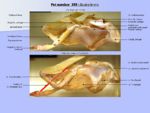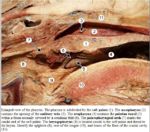Larynx - Anatomy & Physiology
Jump to navigation
Jump to search
BACK TO MUSCULOSKELETAL ANATOMY AND PHYSIOLOGY
BACK TO ANATOMY & PHYSIOLOGY
BACK TO MUSCULOSKELETAL ANATOMY AND PHYSIOLOGY
|
|
Introduction
The larynx is situated below where the pharynx divides into the trachea and the oesophagus. It is contained partly within the rami of the mandible and extends caudally into the neck. Vocal folds and vestibular folds are present in the larynx and due to this, it is more commonly known as the voice box.
The cartilageous larynx can be manually palpated in the living animal and is commonly implicated in respiratory conditions such as roaring.
Structure
- Pharynx rostrally
- Trachea caudally
- Bilaterally symmetrical
- Tube-shaped
- Musculocartilagenous organ
- Suspended from the hyoid apparatus
- Moves position when the animal swallows due to its attachments to the tongue and the basihyoid bone of the hyoid apparatus by the thyrohyoid membrane
- Synovial joints
- Between the thyrohyoid bone and the dorsorostral aspect of the thyroid cartilage
- Dorsal joint of thyroid cartilage
- Lateral aspect of cricoid cartilage and dorsocaudal aspect of thyroid cartilage
- Between cricoid and arytenoid cartilage allowing abduction and adduction of the arytenoid cartilages
- Movement of the cricoid-arytenoid joint controls the size of the glottic opening, lumen and larynx
- Membranes and elastic ligaments attach the laryngeal cartilages
- Epiglottis to throid and cricoid cartilage
- First tracheal ring with cricoid cartilage by the cricotracheal ligament
- Extrinsic musculature connects the larynx to the sternum, tongue, pharynx and hyoid apparatus
- Intrinsic musculature connects the laryngeal cartilages (see here)
- All skeletal muscles
- The vestibule extends from the entrance of the larynx to the arytenoid cartilages and vocal folds
- Vestibular folds run parallel, but rostral to, the vocal folds
- The glottic cleft (rima glottidis) is surrounded by the arytenoid cartilages dorsally and vocal folds ventrolaterally
- Varies in size
- Diamond shaped
- Glottic cleft disappears when the glottis is closed
- Vocal folds run caudodorsally
- The infraglottic cavity extends from the caudal section of the arytenoid cartilages into the lumen of the trachea
- Fixed size
- Epiglottis is the rostral margin of the larynx
The Cartilage of the Larynx
Thyroid Cartilage
- Forms most of the floor of the larynx
- Fusion of the two lateral plates varies in different species
- Rostral part forms the 'Adam's apple'
- Articulates with the thyrohyoid bone
- Articulates with the cricoid cartilage
- Becomes brittle as the animal ages
Cricoid Cartilage
- Signet ring shape
- Wider on dorsal surface
- Narrower on ventral surface
- Crest on midline of dorsal surface
- Facets for arytenoid cartilages on rostral egde
- Articulates with the thyroid cartilage
- Becomes brittle as the animal ages
Arytenoid Cartilage
- Paired
- Articulates with the rostral part of the cricoid cartilage
- Vocal process present on caudal surface where the vocal folds attach
- Muscular process extending laterally
- Corniculate process extending dorsomedially (elastic cartilage)
Epiglottic Cartilage
- Flexible
- Most rostral
- Thinner stalk-like part is attached to the root of the tongue, body of the thyroid cartilage and the basihyoid bone
- The larger blade-like part lies behind the soft palate and points dorso-rostrally
- During deglutition the large blade part of the epiglottic cartilage partially covers the entrance to the trachea
Interarytenoid Cartilage
- Nodule of hyaline cartilage
- Between arytenoid cartilages dorsally
Cuneiform Process
- Supports mucosal folds from epiglottis to arytenoid cartilages
- Not present in all species
- Free or fused with the epiglottic cartilages and arytenoid cartilages depending on species
The Vocal and Vestibular Folds
Vocal Folds
- Made of (slightly stiffer) elastic ligaments
- Pass between the arytenoid cartilages and the laryngeal floor
- Run caudodorsally
- Ligament medially
- Vocalis muscle laterally
- Fat surrounds vocalis muscle
- Form part of the glottis
- Secrete mucous
- Vocalisation
Vestibular folds
- Made of (slightly stiffer) elastic ligaments
- Vestibular ligaments rostral to vocal ligament
- Rostral part of laryngeal floor to arytenoid cartilages
- Run caudodorsally, rostral to vocal folds
- Ligament medially
- Vocalis muscle laterally
- Fat surrounds vocalis muscle
- Do not form the glottis
Intrinsic Musculature
Cricothryroid muscle
- Innervated by the cranial laryngeal nerve a branch of the vagus nerve (CN X)
- Moves cricoid and arytenoid cartilages caudally
- Tenses vocal folds
Dorsal cricoarytenoid muscle
- Innervated by the caudal laryngeal nerve a branch of the vagus nerve (CN X)
- Dorsal surface of cricoid cartilage to arytenoid cartilage
- Abducts vocal process and therefore vocal fold
- Widens glottis
Lateral cricoarytenoid muscle
- Innervated by the caudal laryngeal nerve a branch of the vagus nerve (CN X)
- Adducts vocal processes
- Narrows the glottis
Thyroarytenoid muscle
- Innervated by the caudal laryngeal nerve a branch of the vagus nerve (CN X)
- Laryngeal floor to the thyroid cartilage and arytenoid cartilage
- Alters the tension of the vocal and vestibular folds
- Forms part of the sphincter muscular arrangement
Transverse arytenoid muscle
- Innervated by the caudal laryngeal nerve a branch of the vagus nerve (CN X)
- Completes the muscular sphincter arrangment
- Spans the arytenoid cartilages
Laryngeal Pharynx
- Largest part of the pharynx
- Wide rostrally
- Narrows caudally
- Joins oesophagus at mucosal folds (clearest in the canine, but in other species it is harder to see the demarcation)
- Lumen closed at rest by the roof and walls falling towards the floor
- The floor of the laryngeal pharynx contains the opening into the larynx- epiglottis, arytenoid cartilages and the aryepiglottic folds
Function
- Protects the trachea in Swallowing, preventing aspiration of foreign material
- During swallowing the larynx is moved rostrally causing the epiglottis to partially cover the laryngeal entrance
- Solid foods are carried over the laryngeal entrance by the muscles of the pharynx
- Fluids are deflected by the epiglottis
- Closure of the glottis also prevents food passing down the larynx
- Relfex stimulation of the mucosa promotes the coughing reflex
- Communication
- Passage of air to the lungs
- Increases intra-abdominal pressure
- Vocalisation
- The glottis can widen by adduction of the vocal folds when breathing is vigorous
Vasculature
- Laryngeal branch of superior thyroid artery
- Supplies rostral larynx
- Branch from carotid artery
- Laryngeal branch of inferior thyroid artery
- Supplies caudal larynx
- Branch from subclavian artery from thyrocervical trunk
- Laryngeal branch of cricothyroid artery
- Branch from superior thyroid artery
Innervation
- Branches of the vagus nerve (CN X)
- Cranial larygeal nerve
- Internal branch innervates mucosa
- External branch innervates cricothyroid muscle and constrictors of pharynx
- Caudal (recurrent) laryngeal nerve
- Innervates intrinsic muscles of larynx (except cricothyroid muscle)
- Cranial larygeal nerve
Lymphatics
- Lymphoid tissue present
Histology
- Mucous glands present
- In the ventricles, there is a high density of mucous glands
- Stratified squamous epithelium rostrally around laryngeal entrance
- Ciliated pseudostratified columnar epithelium elsewhere
Species Differences
The variation between the species is significant and is dealt with here
Links
Cartilage - Anatomy & Physiology
Video
Pot 258 Lateral section through the head of a dog






